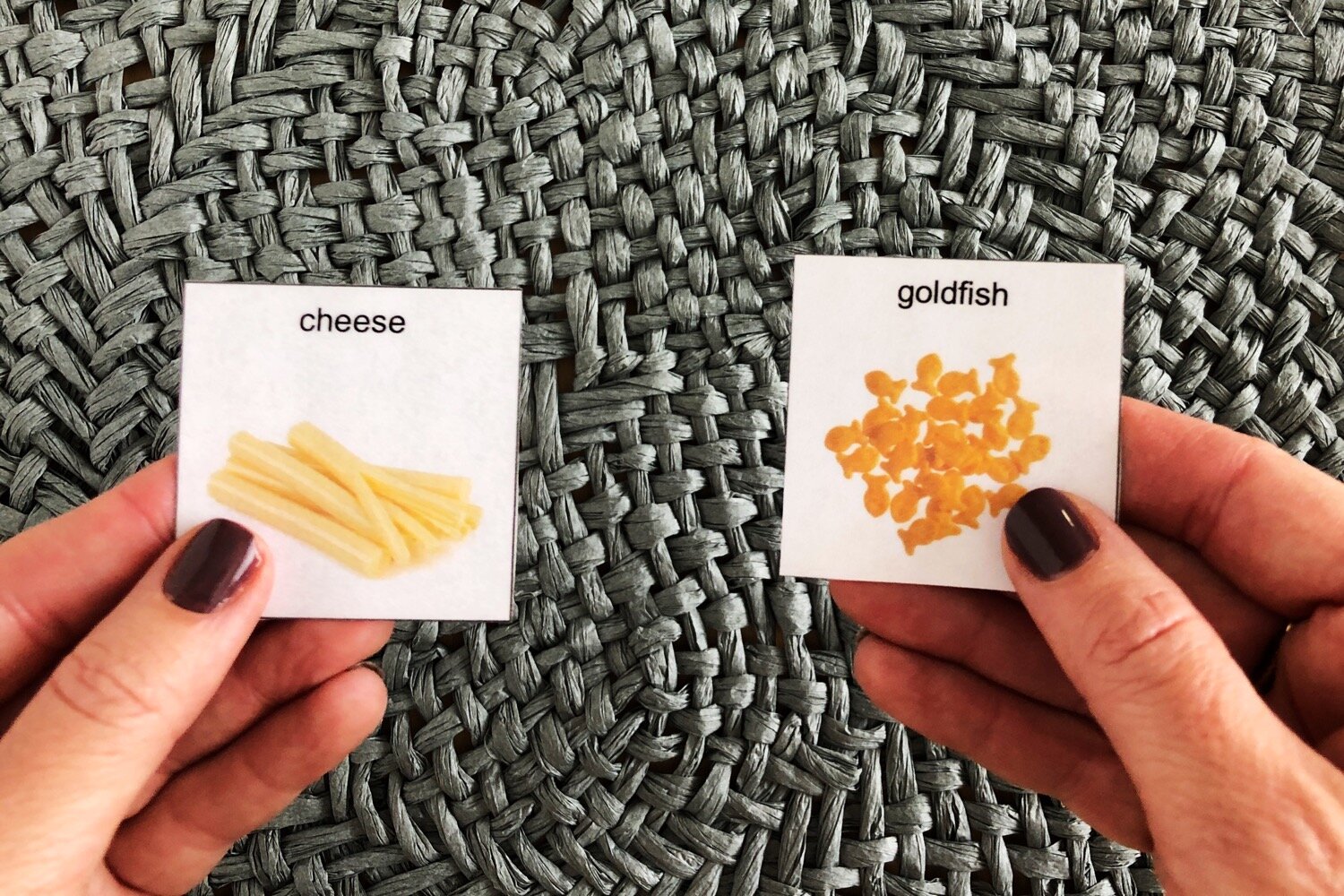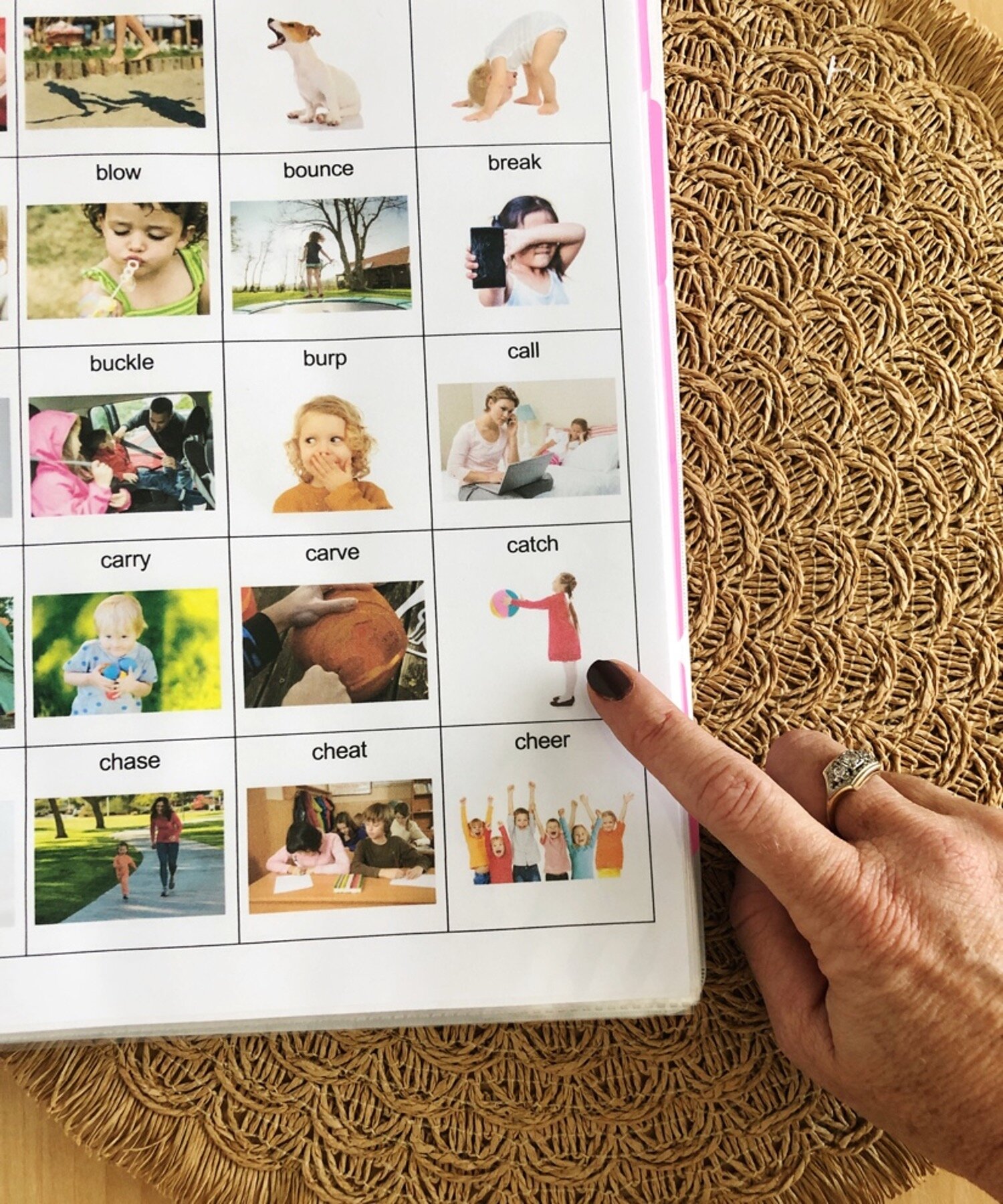Picture Cards: The Most Versatile Visual Supports on the Market
Today I’m sharing why picture cards are a staple in every speech therapist's toolkit. Learn how to use these visual supports most effectively.
If you’re new to the world of speech therapy, you might find yourself overwhelmed by all. the. therapy materials. There are materials for every kind of therapy goal: saying first words and following directions, building sentences and producing speech sounds. Games and books. Visual supports and playsets and apps.
Are you wondering where to start?
Whether you’re a parent or a speech therapist, you want to get the biggest bang for your buck. You want the most versatile therapy materials around because you don’t have an unlimited budget or unlimited space in your therapy bag, your office, your classroom, or your home.
Do you want to know the staple in every speech therapist’s toolbox? My number-one go-to? The tool that seems to work for ALL the goals?
I’ll tell you.
Picture cards.
You’ll never catch me in a speech therapy session without picture cards.
Picture cards are one of the simplest supports for speech and language, and that simplicity is what makes them so versatile. With a stack of picture cards and a dash of creativity, you’ll be well on your way to making speech and language time practical, effective, and fun.
Why Use Visual Supports in Speech Therapy?
To a casual observer, it might not be immediately clear why visual supports are a necessary tool for speech therapy. After all, we’re targeting speech and language, not vision.
But many kids learn best visually. (1) This may be especially true for kids with speech and language disorders. They rely on what they see to compensate for what’s hard, including skills like language.
Using visual supports, then, can help teach them communication.
In speech therapy, we’re all about evidence-based practice. We want to see research that supports the tools and methods we use to teach.
And data consistently tells us that visual supports are effective tools for kids who have communication delays and disorders. (2) Some children in particular, like those with autism spectrum disorders, benefit even more specifically from visual supports such as picture cards. (3)
What Qualifies as a Visual Support?
There are many kinds! Physical objects are the most basic of the bunch. Other examples of visual supports include photographs, realistic drawings, line drawings, and more abstract symbols, either in printed or digital form. Finally, videos and written words fall into the category of “visual supports.”
Of all these options, photographs with written words are a therapist favorite when printed because they are small, accessible, and realistic. Plus, the words help with literacy learning.
Enter: Speech and Language at Home’s therapy picture cards.
The Best Ways to Use Picture Cards for Visual Supports
No matter where your child is at in his speech, language, and communication development, picture cards can help. He’s not directing his communication to you? I’ve got an idea. No words? No problem! Can’t seem to make him understand your language? Here’s how to help.
Build Basic Communication with Visual Supports
Remember the fundamental communication skills? If your child isn’t using words yet, picture cards are perfect tools for building them! Sometimes, even if a child cannot say or understand the word for an object, he’ll still recognize a picture of it.
Begin by using picture cards to help your child make a choice and direct his communication to you.
For example, hold up two cards (ideally one showing an item you know he wants and another showing something he does not). Encourage him to point to or look at the preferred item. If your child is struggling with directing his communication to you, his listener, work on having him give you the picture of the item he wants. Some initial hand-over-hand support from another adult may help him learn this skill.
Model Language using Picture Cards
Keep picture cards on hand to supplement the language you use when speaking to your child. As you give him a direction, ask a question, or make a comment, point to the corresponding pictures of key words.
Pick an engaging book and flip through to find some important vocabulary throughout. This might mean words that show up repeatedly throughout or words that are relevant to the major events in the story.
For example, if you decide to read The Very Hungry Caterpillar (a big-time hit in my therapy sessions), you might choose the five key words: “hungry,” “caterpillar,” “eat,” “big,” and “butterfly.” As you flip through the story with your little one, have the picture cards on the table next to you. When you come across the key words, emphasize them in your speech and point simultaneously to the picture cards that depict them.
Support Expressive Language
Does your child struggle to produce or combine words? Does he resort to grunting and pointing when you know he could say words with a little extra push? Picture cards can help.
Treat pictures like cue cards for expressive language! Practice putting words together by organizing pictures in a sequence.
For example, if you know your child wants you to read him a book, hold up a picture of a book and model the word “book.” See if he attempts to imitate you. Once he’s saying “book,” up the ante and add another picture card like “I want.” As you show the pictures, say “I want” and “book” with a slight pause in between.
Test and Teach Language Comprehension
Picture cards are an easy way to test your child’s receptive language skills! Find out what he knows. But when you do this, make sure you are keeping him engaged, successful, and motivated.
Consider what your child comprehends. Does he understand the names for objects? The names for actions? Can he identify an object by what it does (e.g., something that you eat with or write with)? Find out with picture cards.
To do this, place two or more picture cards in front of your little one. Give a simple prompt such as, “Point to the lion” or “Show me cup.” Does he indicate in some way that he understands the word? If not, teach the skill. Say “lion” while pointing to the respective picture. Give a little roar to provide extra context for learning.
Extra Pro Tips for Picture Card Use
In addition to the evidence-based practices for communication development described above, I want to share a few more picture card tips I’ve learned over the years:
I always recommend that you laminate cards to keep them working for you months and years down the road! The extra protection keeps sticky fingers from ruining the materials, especially if you use laminating folders with a nice weight.
It’s helpful to have picture cards accessible in places where you’ll be using the words. Velcro sticker buttons can help. Put a picture showing “wash hands” in the bathroom. Attach pictures of favorite foods to the fridge to make communicating around snacks a breeze.
Keep frequently-used cards with you on the go. If you find yourself struggling to communicate the same ideas over and over again outside of the house (e.g., “potty,” “more,” “snack,” etc.), put them all together on a key ring and attach it to your bag.
Organize the picture cards in a way that is practical for your family. This might mean putting them into a binder, with different pages for different activities. But it also might mean categorizing words based on frequency of use or part of speech. There are no wrong ways to organize pictures if the strategy is working for you and your little one.
Why Reinvent the Wheel?
I did the curating to save you some time and energy. When you buy Speech and Language at Home’s Picture Card bundle, you’re getting 1,637 picture cards across categories such as Foods, Animals, Transportation, Basic Concepts, and more. (HERE)
If you’ve only got one therapy item in your toolbox, make it these picture cards.
Sources
Via researchgate.net
Via tandfonline.com





